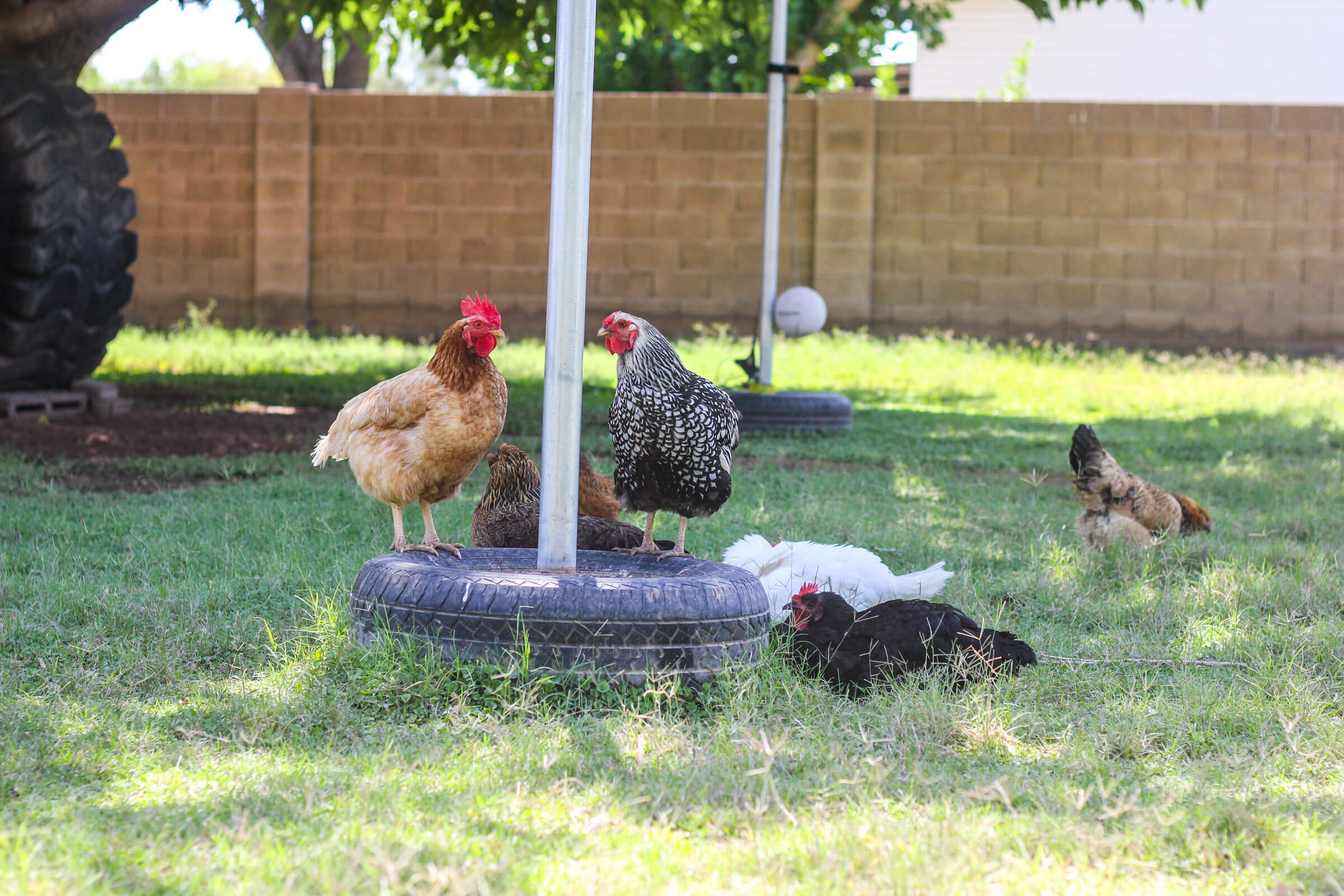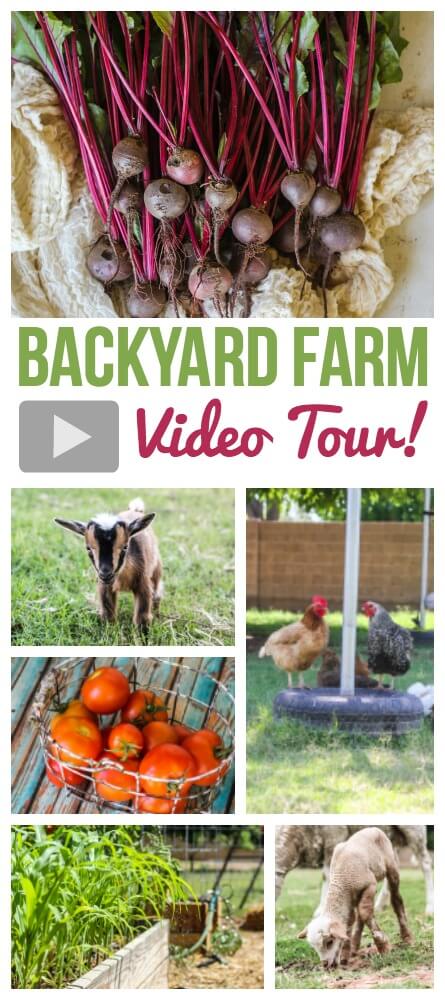
Life on our little backyard farm…
Man, I love it.
I love this little farm so much I want to marry it. Poop n’ all.
You gotta make sacrifices in marriage.
Where am I going with this? Oh right, farming. The fact that I love it.
Growing your own food rocks.
I’m still blown away at how providing our own eggs, milk, meat, fruits, & veggies can be so rewarding. Maybe it doesn’t take much to please me, or maybe there’s a huge basic human reward in being able to place a seed in the ground and have it turn into a bundle of green beans. Even after all this time, 8 years later, I still get a little giddy gathering the eggs each morning.
And the most shocking thing is it really isn’t as expensive as we thought to run our small backyard farm. We live on an acre of land in Phoenix, Arizona. As you can see in the video below, it’s PLENTY of space for us to raise our own food!
CHICKENS
- We have 10-15 laying hens (we lost count a couple years ago – those buggers are constantly moving haha) that give us anywhere from 8-12 eggs per day depending on the time of the year. Laying hens can produce for about 3-4 years pretty well but after that they decline in their frequency. We typically add a few each year because some are lost to natural circumstances (weather or predators). Keeping backyard chickens is one of my favorite things to do!
- Once a year around August, we purchase 30 meat chicks to raise & butcher. These last us all year. It takes about 12-16 weeks to raise this heirloom variety, a few weeks longer than the conventional bird, but we think they taste better and are healthier for it. And over the years, we’ve tweaked our method and found an easy way to raise meat chickens.
GOATS
- We typically have 2 milking goats at all times. If you have a farm, or even a decent-sized backyard, trust me, you need a goat! Our first milking goat is Penny, a Nigerian Dwarf goat – this breed is known for the sweetest tasting milk! She is a smaller goat and only gives us about 1-2 quarts a day. Our second milking goat is Luna, a Nubian goat – this breed is a milking goat known for their large quantity of milk. She gives us about 1-2 gallons per day. This is PLENTY of milk for us! While there are lots of things you can make with goat’s milk, we pretty much stick to homemade yogurt and homemade mozzarella cheese (we like to freeze this and have it on our homemade pizza nights!)
- We breed our goats once a year so they have babies and their milk is “freshened”, so throughout the year we usually have a slew of baby goats running around. Goats can have anywhere from one to four even FIVE OR SIX kids, so you can see why we keep our main milking goats to a minimum. Unless we decide to raise one to become a future milking goat, we usually sell the baby goats to local farmers or FFA kids when their mamas have weaned them.
SHEEP
- In the beginning we raised Katahdin sheep, but have recently moved towards an East Friesian mix. Eleanor is our ewe who recently gave birth to a little lamb we have yet to name! She is the most adorable, loving lamb we’ve ever owned, so she’s definitely a keeper! East Friesians are known for their milk, and since sheep’s milk is my favorite, I plan on milking Eleanor very soon here.
- Once a year, we typically raise a lamb to adulthood, then butcher for meat. This year we aren’t going to because Eleanor gave birth to a female, and we’re going to keep her as an adult.
DUCK/GEESE
- The duck and geese get an honorable mention here because SOMEHOW, SOMEWAY these always seem to make their way to our farm. We’ve either taken them in from homes that no longer wanted them or we’ve succumbed to their adorable fluffiness on a trip to the feed store. Either way, there always seems to be one here and they always (the geese at least) seem to drive me crazy 😉
TREES
Grapefruit/Orange cross (Pomelo variety) | harvest from January-March
Blueberries (Sunshine Blue, O’Neal, Sharp Blue, Misty varieties) |harvest from March-May
Strawberries (Quinault variety) |harvest from March-June
Mulberries (Dwarf & Pakistani variety) | harvest from April – July
Loquat (Christmas variety) | harvest from May – June
Peaches (Florida Prince variety) | harvest from May – June
Blackberries (La Gata Negra variety) | harvest from May – June
Grapes (Black Monukka variety) | harvest from June – August
Mangoes (Kent variety) | harvest from June – August
Cherries (Surinam & Barbados variety) | harvest from July-September
Figs (Texas Blue Giant Fig) | harvest from July – October
Bananas (Goldfinger variety) | harvest from August – November
Almonds (Garden Prince variety) | harvest from August – November
Avocados (Aravaipa & Day variety) | harvest from September – November
Pecans | harvest from November – January
Oranges (Tovita variety) | harvest from December – February
GARDEN
We have a 500 sq. ft garden, and we also will grow vine fruits/veggies in another part of our yard.
- SPRING – Snap peas, Carrots, Parsnips, Lettuce, Spinach, Chard, Kale, Onions, Garlic, Celery, Tomatoes, Peppers, Cabbage, Broccoli, Sunflowers, Cilantro, Parsley.
- SUMMER – Green Beans, Potatoes, Tomatoes, Peppers, Cucumber, Squash, Watermelon, Cantaloupe, Basil.
- FALL/WINTER – Corn, Carrots, Lettuce, Spinach, Chard, Kale, Squash, Pumpkin, Eggplant, Cauliflower, Cabbage, Broccoli, Sweet Potatoes, Watermelon, Cantaloupe, Dill, Mint.




It’s so amazing what you do on your acre of land… I love reading along with all the adventures and words of wisdom.
You have motivated me to be BOLD! Thanks so much for the video tour of your property. We are hoping to buy to Nigerian Dwarf kids soon:)
Hi Danelle! What part of the valley are you in, we’re always looking for a nice neighborhood with irrigation.
Thanks!
Hi Jessica! There are lots of great irrigated lots in Mesa, Chandler, Gilbert, & Queen Creek!
Great video. I love how real you are! And very nice to see some backyard farming in the Southwest. I am envious of your flood irrigation. I’m in Southern California where water/drought is a big issue. I’m still in the early stages of building my mini-homestead, so I have a small garden, but next up is chickens. I hadn’t wanted any other animals, but now I am seriously considering the Nigerian Dwarf goat. Question, since drought is an issue here and it is not wise to plant grass, can I have a goat without grass? Would they be ok on some local weeds and hay?
Hi Rachel,
Yes goats will be fine without grass, they actually don’t prefer it:) More than anything, grass can be great to cool down the area where they lay. Here’s an article on what we feed our goats: https://www.weedemandreap.com/what-do-goats-eat/
I just have to ask, cuz my grandparents kept chickens when I was little, how do you keep your chickens from getting lice? That is my husband’s biggest fear of raising chickens and mine too if I’m perfectly honest.
We’ve never had a problem with it, not one time. As long as chickens have access to sand or dirt, they will give themselves “dust baths” every day, which eliminates mites & lice. Animals have their own way of maintaining their health if given the correct environment.
how many acres do you have?
We’re on one acre:)
Hi, I love your site and your enthusiasm for small scale farming. My husband and I are new to farming and are looking at adding our first goat(s). We were originally considering a male and a female, but are reconsidering since they need to be kept apart (or so it seems). If we were to get two does instead, how do we go about breeding them? It appears you only have does, so do you send them to a breeder? And, if so, how do you find goat sires?
Thank you!!
Hi Paula,
I have LOTS of people around me with goats, so I just found the people who had bucks of the breed I wanted. I then call on them every year and either take my does to them or bring the bucks to me:) It’s a good arrangement!
This video made me so happy☺️ I loved seeing your inspiring little farm! We already have chickens, and your blog has inspired my husband and I to save for a home on land that will allow more fruit trees and more animals, specifically goats! Thank you for sharing!
YAY! I’m so glad!
Enjoyed your farm tour – specially the chickens and your baby lamb. Adorable!! Question for you – the link to your homemade raspberry ginger soda didn’t work for me. Also tried a search, which didn’t work either. Do you have a recipe ? It sounds awesome!!
Hi Judy! Oops, sorry about that! Here’s the link: https://nourishedkitchen.com/raspberry-ginger-soda/
Great video. I have just started looking into avocado plants to grow.thanks. I will go to a little nursery in apache junction near the horse rescue I volunteer at and pick up a few trees.
Awesome! Here’s my article that has more info on raising avocados in the desert! https://www.weedemandreap.com/how-to-grow-an-avocado-tree-in-the-desert/
Yay! Just what I’ve been waiting for : )
love this! I am seriously thinking of doing a little farm. I have talked my husband into chickens for sure but not for a couple of years. We will be retiring. I currently live in the Las Vegas area but plan on relocating to Idaho…was wondering about how many hours per week do you think you spend maintaining your farm?
Hi Carly! It really is only about 30 minutes a day of maintenance, with projects here and there. Not as bad as you’d think!
You’re the best 😀 Such an inspiration and great educator! Keep up the good work – we appreciate you!! PS – great video!!
Samantha,
What a kind thing to say! Thank you so much!